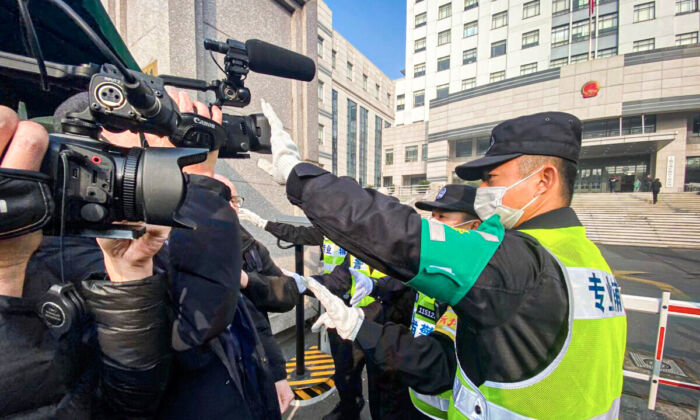News·New
Shell sold millions of carbon credits for reductions in greenhouse gas emissions that never happened, allowing the company to turn a profit on its fledgling carbon capture and storage project, according to a new report by Greenpeace Canada.
Greenpeace describes deal with Alberta as 'hidden subsidy' that awarded money for 'phantom' credits

Benjamin Shingler · CBC News
· Posted: May 07, 2024 4:24 PM EDT | Last Updated: 6 minutes ago

Shell sold millions of carbon credits for reductions in greenhouse gas emissions that never happened, allowing the company to turn a profit on its fledgling carbon capture and storage project, according to a new report by Greenpeace Canada.
Under an agreement with the Alberta government, Shell was awarded two tonnes' worth of emissions reduction credits for each tonne of carbon it actually captured and stored underground at its Quest plant, near Edmonton.
This took place between 2015 and 2021 through a subsidy program for carbon, capture, utilisation and storage projects (CCUS), which are championed by the oil and gas sector as a way to cut its greenhouse gas emissions.
At the time, Quest was the only operational CCUS facility in Alberta. The subsidy program ended in 2022.
During this period, Shell was able to sell 5.7 million tonnes of what Greenpeace describes as "phantom" credits, making more than $200 million for the company. These credits were sold to other oilsands companies on the Alberta carbon market, Greenpeace alleged.
Such sales would not have been illegal, but amounted to a "hidden subsidy" within the program which undercut the effectiveness of industrial carbon pricing, says Keith Stewart, senior energy strategist at Greenpeace and the author of the report.
"Carbon capture projects that have been advertised as a solution to pollution in the oilsands have been almost entirely paid for by the public," he said.
Shell has received $777 million from the federal and provincial governments and $406 million in revenue from carbon offsets, according to company records cited by Greenpeace.
In all, taxpayer funding has covered 93 per cent of the costs of Shell's Quest project to date, Greenpeace said.
Since 2015, the Quest project has stored nine million tonnes of CO2. (By comparison, emissions from the oil and gas sector totalled just over 158 million tonnes in 2022, the most recent federal data available.)
'Smear job'
Carbon offsets are bought and sold under a trading system, with governments putting a price on carbon dioxide emissions to compel companies to fight climate change.
Since 2007, Alberta has run a mandatory carbon offset system for large emitters, such as oil and gas companies. If they produce more than their allotted levels of carbon dioxide, they must purchase credits to offset those emissions.

Ryan Fournier, a spokesperson for Alberta's Environment Minister Rebecca Schulz, said the report is a "smear job by Greenpeace."
Fournier acknowledged in an email that the Alberta government previously offered "important credits to help accelerate CCUS development."
But he described the program as a "targeted incentive to help drive CCUS investments at a time when this was still an unproven technology."
The Quest facility is operated by Shell Canada and owned by Canadian Natural Resources, Chevron and Shell Canada.
In response to the report, Shell Canada spokesperson Stephen Doolan said carbon capture technology is critical to achieving international climate targets.
He said that as "a result of innovative fiscal and regulatory frameworks, nine million tonnes of CO2 have been captured at Shell's Quest facility that would have otherwise been released into the atmosphere."
Neither the province nor Shell denied the sale of the extra credits.
WATCH | CO2 site worries Albertans: 
Massive carbon capture facility worries Alberta residents
Heavily reliant on subsidies
Pierre-Olivier Pineau, a professor and researcher in energy policy at HEC Montreal, said the Greenpeace report illustrates "a key underlying problem" for carbon capture and storage, that "the economic environment isn't yet there to make them sound business."
"It has to rely on subsidies, which become problematic because the government ends up subsidizing polluters," he said, adding that it also shows the need for a higher price on carbon.
"CCUS can only be correctly incentivized through a [higher] penalty on carbon emission," he said.
Without a sufficiently high price, Pineau says CCUS projects will be cancelled because "they are not as profitable as dumping CO2 straight in the atmosphere" — unless, as in the case of Shell, they are heavily subsidized, he said.
Last week, Edmonton-based Capital Power Corp. announced it was abandoning plans to build a $2.4-billion carbon capture and storage project at its Genesee natural gas-fired power plant southwest of Edmonton.
Up to three million tonnes of carbon dioxide per year would have been captured at the facility.
The Pathways Alliance, a consortium of Canada's largest oilsands companies, is still trying to move ahead with a $16.5-billion carbon capture pipeline project, but is seeking about two-thirds of that amount to be covered by subsidies.
Watching for loopholes
Federal data released last week found Alberta was lagging behind other provinces in terms of emissions reductions, with the oil and gas sector still the largest contributor to greenhouse gas emissions.
A spokesperson for Natural Resources Minister Jonathan Wilkinson said "the oil and gas sector needs to move forward on achieving reductions in absolute emissions."
"It is time for the sector to be spending money and putting into place solutions that will reduce carbon pollution and will ultimately strengthen the sector's long-term competitiveness," said Carolyn Svonkin.
In reference to the Greenpeace report, Svonkin noted that the federal government updated its national carbon pricing benchmark in 2021 "to ensure all provincial and territorial pricing systems are comparable in terms of stringency and effectiveness."
"This put an end to processes that could have rewarded industry for emissions reductions that are not real," the statement said.
The federal government is expected to announce details for its emissions cap on the oil and gas sector in the coming months. Stewart said he wants to make sure there aren't similar "loopholes built into it in obscure ways that undercut the effectiveness of the policy."
ABOUT THE AUTHOR

Benjamin Shingler is a senior writer based in Montreal, covering climate policy, health and social issues. He previously worked at The Canadian Press and the New Brunswick Telegraph-Journal.

 1 week ago
45
1 week ago
45










 English (US) ·
English (US) ·  Turkish (TR) ·
Turkish (TR) ·